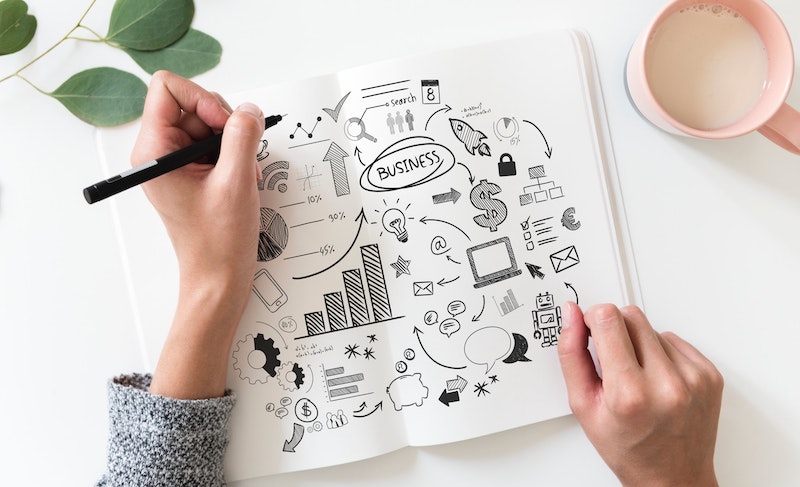
Double-digit conversion rates on your product pages? It sounds unlikely, doesn't it?
That's impossible or at the very least, tremendously difficult. What's worse, the naysayers are right. It is impossible, if you're missing the right ingredients.
But why do you need "ingredients at all?" The problem is trust. Trust, in a customer relationship, develops from repeated, positive interactions over time. These ingredients give customers the evidence they need to assess your perceived trustworthiness.
Your new customers are pessimistic and highly skeptical
The 2017 Edelman Trust Barometer made a sobering discovery. The general public's trust in key institutions - government, business, media, and NGOs fell dramatically worldwide.
Things seem to be getting worse.

This isn't a casual survey either. This is 18 years of research, across 28 markets, with 33,000 respondents total. The findings represent 85 percent of the population in selected markets.
Your customer's default is distrust.
This is bad news, but it's also a wonderful opportunity in disguise.
Here's why.
Let's assume you're running a fantastic business. You're trustworthy. You routinely under promise and over deliver. You're on top of your business in a way your competitors aren't. Let's also assume you're doing what it takes to attract a steady stream of qualified traffic.
Marketing and advertising.
You're going to have two types of customers. Optimists and pessimists. Optimists are easy to sell to, but harder to keep. Pessimists, on the other hand, are harder to sell to, but easier to keep.
The research backs this up.
A meta-analysis by Bart S. Vanneste et al. backs this up. Here's how it works.
- Trustors (customers) enter into a relationship with trustees (you).
- Trustors uses your "perceived trustworthiness" as the fuel or spark they need to take a risk.
- Trustors then adjust their perception to match reality.
Here's where it gets tricky.
- Optimist trustors overestimate trustworthiness. They assign more trustworthiness to you initially. The bad news? Their trust in you decreases over time, they overestimated after all. Even worse, their trust will continue to decline if the gains they receive continue to decline.
- Pessimist trustors underestimate trustworthiness. They assign little to no trustworthiness initially. Any trust that's given has to be earned. As a result, their trust is likely to increase over time. Their trust will continue to increase so long as the gains continue.
Can you see what's happening?
This is the secret to double-digit conversion rates. It's creating product pages (a site really) that caters to your customer's trust mindset.
It's easier to sell to pessimists!
Answer their initial objections, defuse the skepticism they bring with them and you're in. Pessimists require more work on the front end but it's a straightforward way to boost conversions.
What a time to be alive!
Optimists require more work on the back end but they're far more likely to be pleased with the upfront work you've done for pessimists. Work to please your pessimists and you serve both.
You can't please pessimists though...
Not without the right ingredients.
When customers buy, they go through the same specific steps. They bring up the same types of concerns. They look for solutions to problems, fears, and frustrations. Having the right ingredients means you're able to lead them past the barriers preventing the sale.
It means you give them compelling reasons to buy.
Are you with me on this?
Let's look at the ingredients to get a sense of what we'll need on our product pages (and site).
- Precise targeting and focus.
- The emotional product description.
- Reiterating their fears, frustrations, and problems.
- The right features and benefits.
- Is this right for me?
- Risk reversals.
- The irresistible offer.
- Urgency triggers.
- Credibility and authority boosters.
These ingredients give your product pages the power up it needs to outperform your competitors. As we'll soon see, these updates are an important part of your customer's buying process.
- Precise targeting and focus
In many cases, 80 to 90 percent of the work is done here. This is also the most difficult part to sell to leadership in an organization. The response is typically along the lines of: "Oh,we know that already."
That's not enough.
Does your business have a finger on the pulse of your customer? You'll want to be aware of your customers' desires, goals, fears, frustrations and problems. Their demographics and psychographics. Not just initially, as most sellers do, but consistently.
Customers change.
What's acceptable today, may not be tomorrow. And the most important reason for precise customer targeting? All the other ingredients we're about to discuss depend on this step. You can't create a compelling offer if you don't know your customers well. Study your customers and they'll show you how to market to them.
The basics, right?
- Creating an emotional product description
Sellers often treat their product descriptions as a factual retelling of their products attributes. Customers definitely want to know about the specifics of a product, but they're looking for more.
Research shows customers are drawn to these emotional motivators.
Our need for significance. At its core, this emotional desire is about our own uniqueness. Our ability to stand out from the crowd.
Speak to their need:
- Use prestige elements in your copy (e.g. high dollar prestige pricing, luxury) and words like winner, best, highest, as seen on, etc. to describe what they'll receive.
- Mention awards you've received or will give (e.g. customers will receive this certificate, award, badge, etc.).
- Make it exclusive i.e. only available to the first 20 customers.
- Outline requirements only a select few are able to achieve or attain (e.g. only customers who have purchased X may purchase Y. Our products are only made with the finest XYZ material).
Here's an example...

Hope and confidence in the future, a sense of well-being. The future will be even better than the present/past. Things are trending up, your circumstances will improve. You've achieved balance in your life. Your expectations are in sync with your life overall. Your circumstances are stress-free and free from danger.
Speak to their need:
- Minimize or eliminate danger. This product will reduce your store refunds by 97 percent.
- Outline the realm of safety. List what's protected and what's not.
- Share customer feedback that discusses the care and protection you provide.
Here's an example...

The desire for freedom. You have the ability to act without restrictions or obligations. You're able to live independently.
Speak to their need:
- Not restricted by time or place, e.g. customers can access their data anywhere.
- They're unrestricted e.g. they're not locked into a contract. They're able to cancel, upgrade or change their mind at any time.
- No fear of loss. Customers won't lose what they've accumulated. The features, benefits or bonuses they've earned rollover.
Here's an example...

Thrill-seeking and adventure. You experience adventure, pleasure, and excitement. You're able to participate in activities you find fun and enjoyable.
Speak to their need:
- Show other customers having fun and experiencing adventure with your product.
- Briefly mention customers who have had an enjoyable experience with your product.
- Use evocative words, enabling them to insert themselves into your story.
Here's an example...
Source: GoPro
The need to belong. You're part of an in-group. You fit in. You're accepted by your peers, friends, and family. You're part of a group (personal or professional) that provides validation and safety.
Speak to their need:
- Use endorsements from influencers or celebrities they admire.
- Share product photos of customers who are just like them.
- Use social proof (e.g. Join 800K of your peers...).
Here's an example...
Rapha, a clothing retailer, created the Rapha Cycling Club. A club where members (customers) get together at events, summits or simply for a ride.
Protecting the environment. You view the environment, your surroundings as a sacred space that's worthy of protection and care.
Speak to their need:
- Describe your materials and how they're packaged.
- Be specific about the harmful elements you've left out of your product.
- Tell customers where and how you source your materials.
- Show them how you're working to protect the environment.
Here's an example...

Self-actualization. Become the person you know you can/should be. Make consistent progress towards your personal ideal.
- Repeat their values back to them in a way that shows you're one of them.
- Hold your product to a standard that's much higher than your competitors.
- Tell a story that references your commitment to shared values.
Here's an example...
Source: Bigumigu
Safety and security. You value consistency and stability. What you have today will be yours tomorrow. What you put in correlates to what you'll get out.
Speak to their need:
- Minimize or eliminate danger. This product will reduce your store refunds by 97 percent.
- Be specific about how your product protects them from danger. "All data is stored in our secure. datacenters with 24-hour staff, biometric security and redundant power."
- Outline how you respond to crisis, disaster, and loss. Let customers know you have a plan to deal with failure, the unexpected and mistakes.
Here's an example...

Succeeding in life. Your life has meaning, value, and purpose. Your legacy transcends financial or socio-economic concerns.
Speak to their need:
- Share reviews outlining the results others have achieved.
- Repeat their values back to them in a way that shows you're one of them.
- Share product photos of successful customers who are just like them.
Here's an example...

See the difference? Emotional product descriptions tell a story. They share compelling details in a clear, yet concise format. It would be a bad idea to assume that you can't use these strategies in your product descriptions. The examples I've shared are meant to convey an idea.
- Reiterating their fears, frustrations, and problems.
We're drawn to negativity.
Most of us feel it's stressful and upsetting, frightening even. Yet we're all on an obsessive hunt for problems. Science backs this up over and over again.
We have a negative bias.
Dr. John Cacioppo discovered that we have a negative bias. His research shows that from the time we're born we're on an obsessive, never-ending hunt for problems.
There's a good reason for this.
Identifying the fears, frustrations, and problems in our lives keeps us safe. If we find problems we can't be ambushed by them later. We can identify a solution on our terms before we're swallowed up by disaster.
His findings have been replicated by others. You've probably heard about this before. It certainly isn't new. Yet, many marketers refuse to use the problem/solution model, even though the research repeatedly bears this out.
Why?
Many marketers are afraid. They're afraid they'll offend their customers. That these customers will refuse to buy. Simply because they acknowledged their problems. In reality, it's the exact opposite.
Customers want you to discuss their problems.
It's a validation mechanism they use to verify that "you get me." Discussing these issues frankly, with kindness sends an important message. It says: You understand my problems, the headaches, my fears - all of it. You've walked in my shoes and you've come through the other side. Show me how to do the same.

UberConference did this beautifully. Their conference call product outlines the misery and pain customers expect to face, discusses the problem, then presents their product as the solution.
Be kind, do it gently, and customers will give you their full attention.
- The right features and benefits
Earlier we mentioned the importance of knowing your target audience.
Remember that?
Here's another large and very important reason for that push I made for precise targeting earlier.
Startup failure.
CBInsights outlined the biggest reasons for startup failure. They listed more than a dozen categories and reasons, but most of them had minimal impact. Don't get me wrong, they're important, just not the most important. Want to know what was?
No market need.
A little over 42 percent of startups failed because they created a product with features and benefits no one wanted.

The research you've identified in the beginning is key here. This is why it's so important to have a consistent conversation with your customers. When presenting your features, it's a good idea to list your most compelling features, as defined by your customers, first.
What do I mean by that?
It's simple. Customers tell you what their biggest features are. Your pilot customers validate these claims with their behavior. Once that's confirmed, you add these features to your product and your marketing copy.
You feed the features they asked for, back to them.
Do it in your product demos, descriptions, images, and videos. Discuss them online, send it out in product announcements, etc.
Is this right for me?
It's a crucial question that's almost never asked. Retailers don't often see the value behind asking a question like this. It's almost as if retailers feel having money is the only criteria you need to meet.
There's a hidden reason.
Asking this question reduces refund rates. It gives customers clarity. It tells them "this product was made specifically for you." But it also disqualifies the unqualified. So why aren't retailers asking this question?
They often get stuck on minutiae.
I don't want customers to ask if my product is right for them, I just want them to buy it! They're already asking the question though, aren't they?
Isn't that what you do when you buy?
The good news is, you don't have to ask the question the same way. You can get the same information from customers, even if you've changed the wording.
- Is [product] right for me?
- Who should buy this?
- You need [product] if you're struggling with...
- Don't buy this if you're...
See where I'm going with this? Here's how Digital Marketer uses this question.

When you ask this question you get visitors to subconsciously sort themselves! Non-buyers confirm that they're not the target audience and they move on. Buyers receive the validation they need to continue on to the next step in the process.
- The irresistible offer
Your irresistible offer should be built around a specific desire, goal, fear or problem. If you've openly discussed your customer's motivators with them they know they need help.
They're hesitant to give you a chance.
An irresistible offer gives you the opportunity to break the ice with customers immediately.
An irresistible offer uses the following ingredients.
- They want it. Your offer solves a problem, fulfills a desire, meets a goal. Your customers have a strong desire for this particular offer that they're often willing to pay more for it.
- It's exclusive. Customers can only get this offer from you. Your competitors aren't offering the same exact offer. It's not exactly easy for them to get this from someone else.
- The offer is clear. Spell out exactly what you're offering, who can receive it, and any relevant conditions or requirements. Give them the information they need to act on your offer.
- It's timed. Don't extend this offer indefinitely. Give customers a compelling reason to act on that offer today, now. Don't manufacture scarcity. Do give customers a compelling reason as to why they need to act fast.
This offer shouldn't be available to just anyone.
Structure your offer well so it's something predators can't take advantage of. Let's take a look at an example. Survival Life, sells survival products to a specific target audience.
They came up with an irresistible offer that looks like this:

If you're a prepper or you're outdoorsy this is an irresistible offer. But, it's also a fantastic deal for Survival Life. Here's why.
- This offer gets ideal customers to self-identify
- This enables Survival Life to gauge customer interest in specific products
- They're able to get continual feedback from customers (precise targeting remember?)
- Survival Life receives a steady stream of customers who are interested and eager to buy
- Customers receive free products in exchange for helpful feedback
It's a win all around.
- Urgency triggers.
Product pages are historically very deliberate. They're typically heavy on details but slow to instill urgency. How are you supposed to do that anyway? If your product is in stock there isn't really a compelling reason for customers to act right away.
Or, is there?
As it turns out there are lots of ways to get customers to act immediately. These tactics are great ways to train your customers. If the value you provide appears suddenly out of nowhere, they'll learn to pay close attention to avoid missing out.
It's an excellent tactic that helps to boost average order values across the board. Here are a few ways you can instill a (legitimate) sense of urgency in your customers.
- Bonuses. Order by [date] and you'll receive [free product, discount, etc.]
- Takeaways. Only [3] left in this year's batch. Get your [product] now before it's gone
- Loss aversion timer. This bonus is free until the [date] or price goes up in [2 days, 12 hrs, 41 min.]
- Contest. The first 50 customers to pass this test wins a [list prize here]
- Invite/vip only. Exclusive to members of the [group] club receive these free [products, bonuses, freebies] with their order
- Join the waitlist. Purchase this [product] today and you'll be added to the waitlist for our [desirable bonus or incentive]
- Bundled opt-in. Take our quiz and you'll receive this [product or bonus] free with your order.
See what I did there?
By listing these incentives on my product pages, I've given customers a clear and compelling reason to buy. Not later on. Not next week or sometime in the near future. Now.
Right now.
Here's the best part. You can mix and match these offers. You can increase the urgency behind an offer by combining it with various urgency triggers. Here's an example of that in action.
Product+Bonus+Loss Aversion Timer
You can create any combination you choose. You can come up with your own. The sky's the limit, really. As long as you're precisely targeting the right people, your offer will be compelling.
- Credibility and authority boosters
Pundits often make a mistake.
They use credibility synonymously with trust. But they're not the same thing. Not at all. In fact, presumed trust is the byproduct of all of these ingredients.
Here's an example.
Mark Zuckerberg is the co-founder of Facebook. He has credibility in spades. He's a powerful influencer that's created a product that billions of people use every single day.
So, why don't people trust him?
Recent surveys would suggest that many, many people don't. Maybe you trust him, maybe you don't. That's not really the point here.
You can be both credible and untrustworthy at the same time.
That is the point.
According to BJ Fogg, a researcher at Stanford's Persuasive Tech Lab, there are four kinds of credibility which people use to assume trust.
- Earned Credibility. Your customers have had a positive experience with your website. They're pleased with your values, product offerings, etc. They're able to find what they need. They feel your website is credible and valuable.
- Reputed Credibility. This is a third-party referral. Online reviews via platforms like Amazon or Yelp. Positive feedback from family, friends, and peers, etc. It's someone you know or an unbiased source with no conflicts of interest.
- Presumed Credibility. This refers to familiarity and repetition. A brand with presumed credibility is one you've seen before. Customers are more receptive to familiar brands than they are to unknowns.
- Surface Credibility. A customer's subjective assessment of your overall presentation. Your design is professional and appealing. The user experience is easy, pleasant and straightforward. Your content is exceptional and well written and so on. Long story short you convey excellence.
Adding these credibility boosters is part of the formula that increases presumed trust. How exactly do you do that?
- Add online product reviews to your product pages
- Display trust seals (Norton Secured, GoDaddy Secured, BuySafe Verified)
- As seen on badges listing where your product has been featured or displayed
- Embedding positive feedback via social media platforms (e.g. Twitter, Instagram)
- Testimonials from customers willing to share their contact info that can be validated
Pretty straightforward, right?
Many stores are already doing this, on separate pages. Placing these details on product pages directly gives customers the data they need to make a buying decision, at the decision point itself.
This gives customers what they need.
You're still going to need to make sure that your store has all of the basic criteria (professional design, excellent copy, solid marketing, etc.) in place. You'll also want to make sure your business/website performs well on other fronts.
New customers are likely to be pessimists
Many have been burned in the past.
The public's trust in key institutions, in businesses and brands, isn't where it used to be. It seems as if things are getting worse. These days, your customer's default seems to be stuck at distrust.
That's great news.
Knowing means you have a chance to do something about it. To show customers you're one of the few retailers they can count on to be trustworthy. Why do these changes produce double-digit conversion rates?
Trust is in short supply.
Give customers the ingredients they need to presume trust and you'll find you have everything to win the sale. Reinforce the message of trustworthiness and you'll find double-digit conversion rates are just a routine part of your high-performance business.



.png)